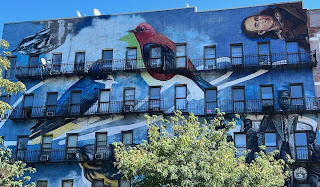 |
| With Suzanne and Robert Indiana's LOVE (Red Outside Blue Inside) |
Case in point: The Robert Indiana "LOVE" sculpture Suzanne and I came across outside Rockefeller Center. We had to queue up to have our picture taken in front of the iconic sculpture.
The work has lived in multiple places in the City. It was initially installed in 1971 at one of the entrances to Central Park. During my time in NY, it could be found at Sixth Avenue and 55th Street. Eventually the sculpture had to be restored because so many people had climbed up on it for a photo opp. I understand the temptation, but really? (I digress, but there seems to be an increasing number of reports of tourists damaging artwork while in search of a selfie. Click here for a shocking example -- with video -- of a tourist reclining on a classical work IN A MUSEUM that led to two toes of the sculpture being broken off.)
"LOVE (Red Outside Blue Inside" -- along with some of Indiana's number sculptures and a flag series commemorating the lives lost on 9/11 -- will be on display at Rock Center until mid-October. The next location is TBD. I like the idea of moving the work around to enable more people to enjoy it. And here are a couple of fun facts. Indiana's "LOVE" sculptures were inspired by a 1965 holiday card he was commissioned to create by MOMA. And while many people associate the sculptures with romance, the design was actually a nod to Indiana's religious upbringing and references his 1964 painting "Love is God." For more on Indiana and his "LOVE' series, click here.
 |
| One of three stained glass panels from Kehinde Wiley's "Go" |
I was able to see two of the three works commissioned for the project -- Kehinde Wiley's "Go" and Elmgreen & Dragset's "The Hive." The third work -- "Penn Station's Half Century" by Stan Douglas -- can be found in Amtrak's ticketed waiting room. While Wiley's work seems to be everywhere these days, I was still excited to see "Go." Wiley has truly captured the movement of the break dancers. The stained glass triptych is located in the ceiling of an entry way to Moynihan Hall, inviting comparison to ceiling frescoes in old churches. Click here to see all three works in Moynihan Train Hall and here for a piece in the NY Times about the project. Now if we could just get more people to look up as they rush to catch their train...
 |
| "Endangered Harlem" by Gaia |
Despite having a map in hand, the murals weren't as easy to locate as anticipated. We knew in advance that many of the murals were painted on pull down gates and are only visible after business hours. But it was disappointing when an address that boasted multiple murals was nowhere to be found. Still, we persevered.
"Endangered Harlem" by Gaia spread across three separate buildings. This plus the fact that some people are included in the mural made it unusual. The man at the top right is John James Audobon (who is buried in a nearby cemetery). I get that reference. The young Black men at the bottom right are from a photograph taken by Russell Lee in the South Side of Chicago during a second wave of migration from the South in 1941. Clever. A portrait of James Lancaster, leader of the East India Company's first fleet in 1600, is on the lower left side of the mural and is unfortunately not visible here. Again, a tip of the hat to a different type of migration. And then there are the birds. All are passerines, or songbirds, and all are endangered. Gaia has depicted a Magnolia Warbler, a Scarlet Tanager, a Tree Swallow and a Black-and-white Warbler. For more on the mural, click here. And to see more of Gaia's work, click here. He's the real deal.
 |
| "Blackburnian Warbler" by George Boorujy (2017) |
Boorujy is an artist whose work focuses on our relationship with the environment. He has painted multiple murals for the Audubon project. Boorujy was inspired by a personal experience to paint this particular bird. "I entered a grove [in the Great Swamp National Wildlife Preserve in New Jersey] and found myself surrounded by what seemed like dozens and dozens of tiny, brightly colored birds. There were no leaves on the trees and the branches looked decorated with orange and yello and black. I found out later that what I witnessed may have been a migratory 'fallout,' when great numbers of migrants 'fall' out of the sky due to weather. There were a few different species, but the one burned into my memory was the Blackburnian." Artists' inspiration is endlessly interesting to me.
For more on the Audubon Mural Project, click here. You can see all of the murals -- and read about the artists and the works -- from the comfort of your home. It's the next best thing to being there.
.jpg)


Nanette - so interesting! so informative! I thought the Robert Indiana started out as a postage stamp. Silly me. I would love to do the NYC Audobon tour. Printed out the map. Looking for someone to go with me ;-) Also going to be doing Vashon Island tour next time I visit & checking out what's in DC. thanks.
ReplyDelete